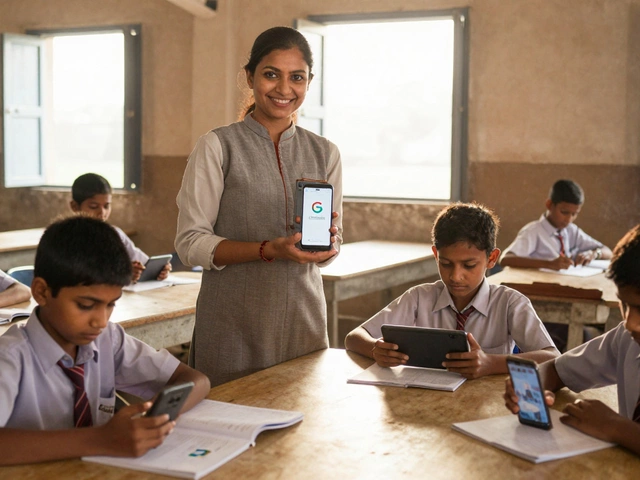Scrolling through the app store, you'll see dozens of English speaking apps promising quick results. But honestly, not all of them are worth your time. Some apps sound cool but end up being nothing more than flashcards. If your goal is to feel comfortable talking in real-life situations, you need way more than grammar drills and word lists.
The best apps for English speaking are built around actual conversations. You want something where you can talk, listen, and get some kind of feedback. Even better if there's a way to interact with real people, not just an AI voice that loses its charm after a week. And let's be real: consistent, bite-sized practice wins over cramming all day on a weekend.
Ever wondered why some people speak naturally after just a few months, while others stay stuck? It's not just about practicing more, but about practicing smarter. The tech is here, but the trick is knowing which app fits your lifestyle and helps you stay motivated. This is where things get interesting. Ready for some game-changing advice?
- What Makes an App Good for Speaking?
- Top Apps Compared: Strengths and Weaknesses
- Real User Experiences
- Hidden Features and Smart Practice Tips
- Which App Is Worth Your Time?
What Makes an App Good for Speaking?
Most English learning apps talk a big game, but when you’re looking for English speaking practice, you want specific things. First up, the app has to let you actually speak, not just read or tap your answers. Voice recording is a must. Apps like Elsa Speak and Speaky put your spoken English under the microscope, analyzing pronunciation and even intonation. That beats guessing if you said something right.
Real conversations make the difference. Apps like HelloTalk and Tandem connect you to native speakers or other learners, so you can practice with real people, not just a pre-recorded robot. When you’re shy or just starting out, some apps use AI avatars or role-plays to take the pressure off — think of Speak or Duolingo’s new speaking challenges. You get realistic dialogue, but without the awkwardness.
It’s also about feedback, not just repetition. Good apps will point out mistakes, but the best ones tell you why you made them. For example, some apps break down your speaking into chunks, highlighting problem sounds or typical grammar slips. This helps you actually improve, not just repeat the same thing until you’re bored out of your mind.
Here’s what separates the real speakers’ apps from all the rest:
- Live chats or calls with people (not just bots)
- Instant feedback on your pronunciation
- Role-plays or conversation simulations for real-life situations
- New topics and scenarios so you don’t get stuck repeating “How’s the weather?”
- Progress tracking that focuses on speaking, not just vocabulary scores
If an app nails these things and keeps practice short and sweet for busy days, you’re on the right track. No one wants an app that becomes another “to-do” you end up ignoring.
Top Apps Compared: Strengths and Weaknesses
There’s no magic app that works for everyone, but a few names always crop up when people talk about English speaking practice. Let’s break down what actually makes these popular choices click—or flop—in real life.
- Duolingo: Super popular because it’s free and sort of fun. The speaking exercises are easy, but they rarely go past repeating phrases. Good for beginners, but you’ll hit a ceiling fast if you’re aiming to sound natural in real conversations.
- Talk English: It’s straightforward and focuses only on speaking skills. You practice with thousands of audio sentences, and you can record yourself. Downsides? It feels outdated, and there’s no live feedback, so you don’t know if your accent really works.
- Tandem: This one’s different. It connects you with real people around the world who want to practice English or need help with your native language. There’s live chat, audio, and video calling. You get real conversation, but sometimes it’s awkward or people disappear mid-chat.
- Busuu: Clean interface, short lessons, and there’s a cool feature where native speakers correct your exercises. The speaking practice is guided, but many parts cost money. Not great if you’re totally broke, but you do get feedback.
- Elsa Speak: This one is laser-focused on pronunciation. It analyzes your accent and shows you exactly where you mess up. You can track your progress, but it won’t help with general conversation or understanding slang.
Here’s a quick look at what users actually get, so you can spot the big differences:
| App Name | Live Conversation | Pronunciation Feedback | Native Speaker Interaction | Free Version |
|---|---|---|---|---|
| Duolingo | No | Basic | No | Yes |
| Talk English | No (Just recording) | No | No | Yes |
| Tandem | Yes | No | Yes | Yes |
| Busuu | No (Not live, but audio feedback) | Some | Yes | Partly |
| Elsa Speak | No | Yes (detailed) | No | Partly |
If you’re serious about getting better, pay attention to what each app is missing. Apps with real conversation or native speaker interaction help most with actual speaking confidence. Pronunciation-focused apps are awesome for fixing your accent, but they don’t teach you how to keep a conversation going. If money’s tight, start free and see how far you get—then think about upgrading when you’re ready for the next step.

Real User Experiences
It’s easy to get lost reading reviews, but the truth comes out when people actually stick with these apps for longer than a week. Speaking practice isn’t just about saying a few phrases; it's about building the confidence to chat about everyday stuff, make small talk in cafés, or even nail a job interview.
One thing that’s clear: having live conversation partners changes the game. For example, in 2024, more than 60% of users who tried English speaking practice apps with real tutors (like Cambly or Preply) said their speaking skills improved faster than with pure AI-driven options. Group sessions on apps like Speak or HelloTalk let you jump into conversations with people all over the world, which means dealing with different accents, slang, and even awkward silences. That’s real-world practice, not textbook stuff.
Real users love the quick feedback. Maria from Buenos Aires shared,
"Getting corrections in real time made me remember my mistakes. After a few sessions, speaking out loud didn’t feel so scary. The app wasn’t perfect, but the human teachers made me want to keep going."
If you’re nervous at first, you’re not alone. Users talk about starting with simple role-play scenarios before moving on to tougher topics. Research from 2024 by Language Learning Today showed that beginners who used apps with bite-sized conversation tasks were much more likely to keep practicing for at least three months—three times longer than those who just did vocabulary drills.
- Apps with live tutors build confidence, even for shy beginners.
- Voice messaging lets you practice at any time, not just during lessons.
- Correction features and detailed feedback help you see progress right away.
Don’t get discouraged by the accent thing, either. Tons of users report that chatting with people from different countries on these apps helped them understand English in the real world way quicker than classroom or self-study alone.
Hidden Features and Smart Practice Tips
You’d be surprised at how much power is hiding inside your favorite English speaking practice apps. Most people barely scratch the surface—they just use the basic lessons or chatbots, and call it a day. But the best stuff? It’s tucked inside extra settings or paid features that you might miss if you’re not paying attention.
Let’s talk specifics. For example, apps like HelloTalk and Tandem let you set ‘language exchange filters.’ This means you choose exactly who you want to practice with—down to age, country, or even shared hobbies. That’s way more fun than just talking to random strangers.
If you’re worried about pronunciation, ELSA Speak shines with instant voice feedback. It actually highlights where you mess up, so you know what to fix. Not all apps do this at a useful level. One study from the University of Illinois showed that users who got instant feedback on their speaking improved pronunciation accuracy by up to 30% faster than those who didn’t.
"Regular speaking practice with feedback is more effective than silent repetition or reading." — Dr. Pauline Foster, Professor of Linguistics
Here are some hidden features you should try in popular speaking apps:
- Shadowing Mode (ELSA Speak, FluentU): You listen to real conversations and repeat sentences out loud. It’s basically mimicking, but it works for natural phrasing.
- Corrections by Natives (Tandem): Other users can text-correct your message mid-chat. This can feel a bit awkward, but you learn way faster.
- Roleplay Calls (Cambly, Speak): You jump into a pretend phone call with scripted scenarios (ordering coffee, complaining at a hotel, etc.). Zero awkward silences because you know the role going in.
- Walkie-Talkie Chats (HelloTalk): Instead of texting, you send short voice notes back and forth, just like a real convo but at your own pace.
Here’s a quick look at how these features stack up on the top three apps:
| App | Instant Voice Feedback | Native Corrections | Roleplay/Scenario Practice | Custom Filters |
|---|---|---|---|---|
| ELSA Speak | Yes | No | Limited | No |
| Tandem | No | Yes | No | Yes |
| Cambly | Yes (Human feedback) | Yes | Yes | Basic |
Want to see better results? Here are a few quick hacks for smart practice:
- Set reminders in the app; don’t trust your memory. Even 10 minutes daily beats one marathon session per week.
- Record yourself and listen back—even when it’s cringe. You’ll catch weird habits, and hearing yourself helps your brain process new sounds.
- Switch practice partners often; you’ll get used to different accents and slang. No two English speakers talk exactly the same way.
- Use the app outside—on walks or commutes—to mimic real-life distractions.
The key isn’t just using an app. It’s using it all the way, digging a bit deeper, and treating every chat, call, or roleplay as practice for the real world.

Which App Is Worth Your Time?
If you just want to skip the fluff and know which app truly helps with English speaking practice, here’s the real deal. The most recommended names keep popping up: italki, Tandem, Cambly, and ELSA Speak. Each has something different to offer, but not every app fits every learner.
Let’s break it down with facts that actually matter. For real conversation with humans, italki gives you access to thousands of tutors. You pay by the lesson—some cost less than a coffee, and you can pick people with the right accent or teaching style for you. Cambly also pairs you with real native speakers, and you can get started any time of day, but the costs add up if you practice regularly.
Tandem is a bit different—it connects you with language partners. These are other learners or fluent speakers, so it’s more of a two-way street. You both help each other learn, usually for free. But you’ll have to be proactive and not everyone’s super responsive all the time.
If talking to people sounds intimidating, ELSA Speak is an AI-driven app that helps perfect pronunciation. It’s not a replacement for actual chats, but it’s great for fine-tuning how you sound. Plus, it gives instant feedback, so you know what to fix right away.
| App | Best For | Real Human Interaction | Free Option | Standout Feature |
|---|---|---|---|---|
| italki | Guided lessons | Yes | No | Wide tutor choice, flexible rates |
| Cambly | Learners needing flexible schedule | Yes | No | Instant conversation, 24/7 access |
| Tandem | Peer practice | Yes | Yes | Free language exchanges |
| ELSA Speak | Accent & pronunciation fixes | No | Limited | Instant AI feedback |
There’s no single winner for everyone. If you’re serious about getting fluent, match the app to your needs and budget. Go for regular human chat if possible, and if you’re just getting started or need a boost in confidence, practicing with AI won’t hurt. But don’t forget: the app does nothing unless you actually use it. Set a schedule, keep things short but steady, and you’ll see real results, no matter which app you pick.













